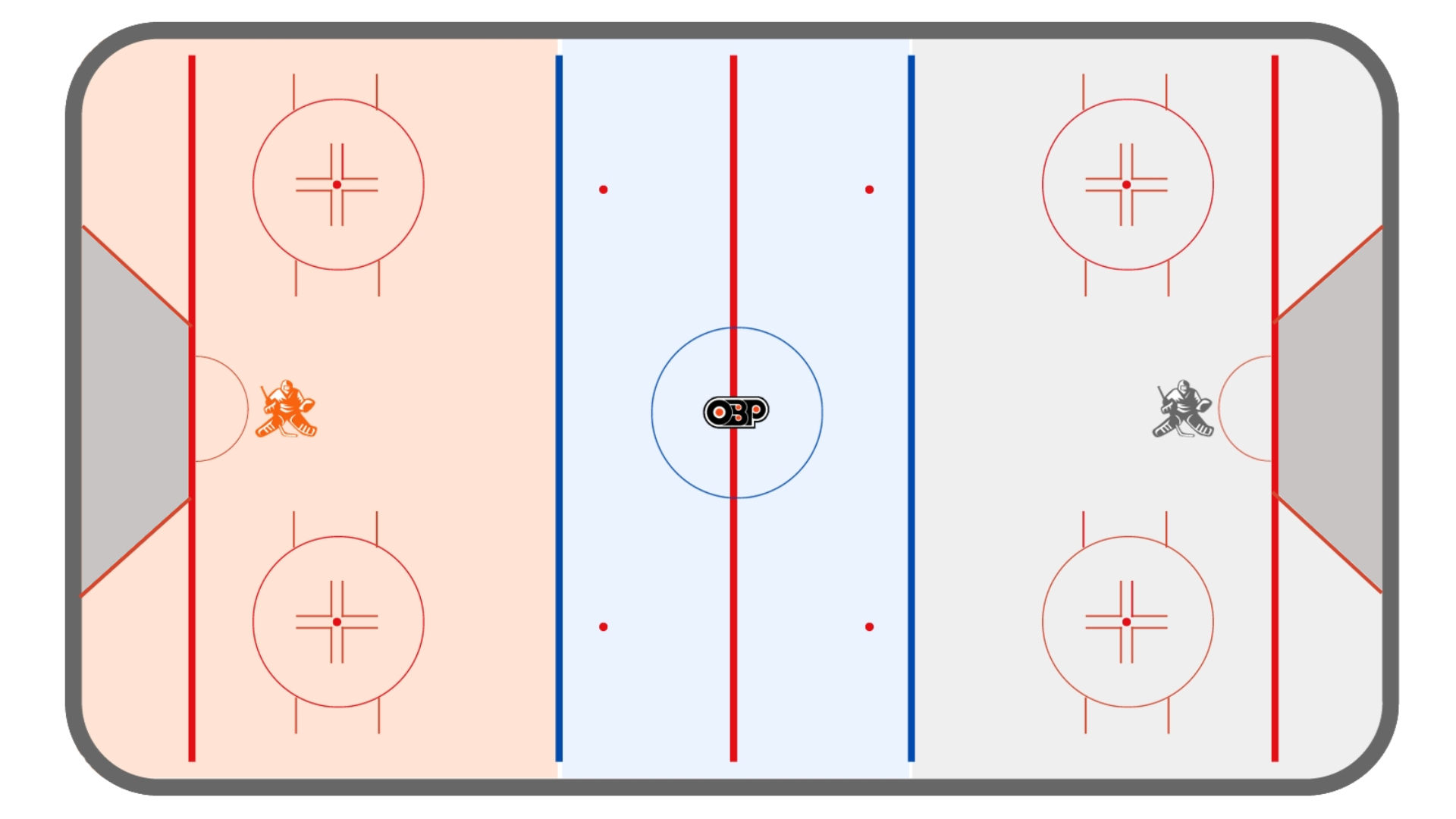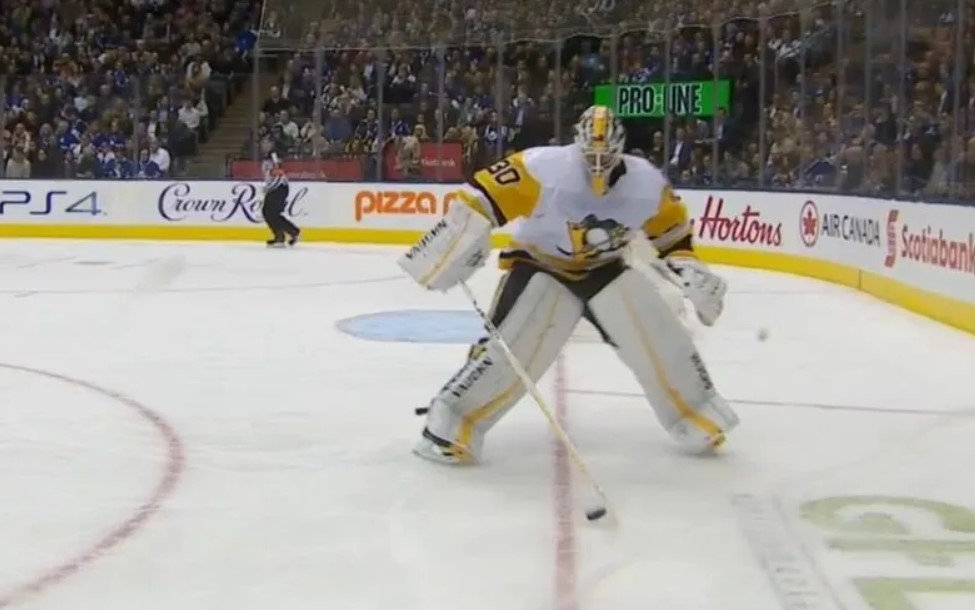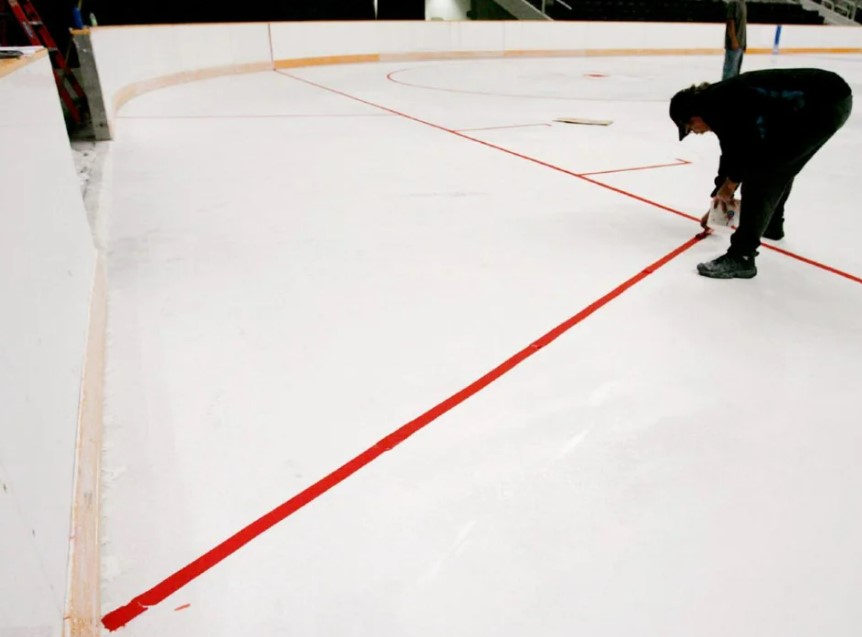
After digging deeper into the NHL rulebook and reading seasoned players’ interviews, I’ve got the scoop on why hockey trapezoid, a unique area behind the net, exists and how it affects game play.
Table of Contents
Toggle
The Trapezoid in hockey refers to the area behind the goal line and in the corners of the defensive zone where goalies are restricted from playing the puck.
In hockey, a trapezoid is a designated area behind the goal line. This unique shape is painted onto the ice and serves an important purpose – it’s the only space where the goalie can play the puck behind the net without incurring a penalty.
Stepping outside this trapezoid to play or control the puck earns the goaltender an unpleasant 2-minute timeout from gameplay. The birth of this rule aimed at boosting scoring within NHL games by limiting how much control goalies had over possession and cutting down on their ability to prevent opposing teams from getting near their net.
The NHL lockout in 2004-2005 marked a turning point. It gave birth to a rules committee tasked with finding ways to increase offense in games. One of their innovative decisions was the introduction of the hockey trapezoid, forever changing how goaltenders engage with the puck outside their crease.
This change meant that any time a goalie stepped out to handle the puck, they had to be within this specific shaded area behind their net, known as the trapezoid. Straying from these confines led to penalties; a two-minute breather for goalies who dared test the boundaries of new regulations.
With this sudden shift, an entirely new layer of strategy unfolded on ice rinks across North America and beyond. Players were forced to adjust and adapt novel approaches while navigating around their opponent’s net.
Here’s what the goalie restrictions in hockey entail. The trapezoid, often referred to as “The Brodeur Rule,” limits where goalies can play the puck behind the net. This regulation confines goaltenders within a strict boundary at the back of their team’s defensive zone.
Goaltenders playing or handling the puck outside this designated area face a 2-minute penalty for delay of game. These regulations confine how freely goalies can assist their defense by swiftly retrieving pucks and passing them off or clearing from potential danger zones.
Now it all boils down to how well these masters of net protection adapt and maneuver within this restricted space during an intense game!
Read why you should get the best neck guards for hockey.

The Trapezoid in hockey was implemented as a rule in the NHL to address specific concerns and improve the game.
The Martin Brodeur Rule is a significant part of the history and reasons behind the trapezoid in hockey. This rule was introduced to limit goaltenders, like Martin Brodeur, from playing the puck outside of their crease.
Before this rule, goaltenders were highly skilled at retrieving pucks and passing them to their defense, which made it difficult for the opposing team to gain possession. However, with the introduction of the trapezoid, goaltenders now have restricted ability to help their defense by quickly retrieving pucks and clearing them.
The aim was to increase scoring in the NHL by limiting the influence of goaltenders outside of their crease.
The introduction of the trapezoid rule in hockey was aimed at achieving two important goals: increasing offense and enhancing player safety. By limiting goaltenders’ ability to play the puck outside of their crease, the NHL hoped to discourage defensive strategies like the neutral zone trap and encourage more offensive plays.
This change has led to a faster-paced game with increased scoring opportunities for players. Additionally, by preventing goalies from venturing too far from their net, there is reduced risk of collisions and injuries between players on the ice.
Overall, this rule has successfully achieved its objectives of making hockey more exciting while prioritizing player safety.

Many players and fans have voiced their concerns about the Trapezoid, citing confusion, disadvantages for defensemen, skill level discrepancies among goalies, and changes to the style of play.
Players and fans in the hockey community have expressed their confusion and disagreement regarding the implementation of the trapezoid rule. They argue that this rule restricts the goaltender’s ability to assist their defense by quickly retrieving pucks and effectively clearing them.
These concerns have led to a lively debate among players, fans, and experts about the impact of the trapezoid on gameplay and strategy. There is a lack of consensus on whether this rule has actually achieved its intended purpose of increasing offensive opportunities in professional hockey.
As a defenceman myself, I’ve often found the trapezoid rule to put us at a disadvantage on the ice. This rule restricts goaltenders from playing the puck outside of a designated area behind their net.
Before its implementation, goalies like Martin Brodeur were experts at retrieving pucks and quickly transitioning them to their defense. However, with the trapezoid in place, it’s become much harder for us defencemen to clear the puck and regain possession.
It feels like we’re fighting an uphill battle against opposing forwards who can now easily forecheck and disrupt our plays.
Some goalies are more skilled at stickhandling and playing the puck outside of their crease than others. The trapezoid takes away the excitement of watching these goalies create adventures and mishaps outside of the net.
It limits their ability to help out the defense by quickly retrieving pucks and makes it more difficult for them to clear the puck. This has been a point of controversy, as some argue that it puts certain goalies at a disadvantage compared to others who are not as proficient in stickhandling.
The implementation of the trapezoid rule in hockey has had a significant impact on the style of play. With goalies restricted from playing the puck outside of the designated area, it has become more difficult for them to help their defense by quickly retrieving and clearing pucks.
This has forced teams to adjust their defensive strategies and rely more heavily on their defenseman to handle the puck. Additionally, it has also led to faster transitions and increased pressure in the offensive zone as teams try to take advantage of limited goalie mobility.
Like it or not, the trapezoid rule has altered the dynamics of gameplay and required teams to adapt their strategies accordingly.
Has the hockey trapezoid rule actually increased scoring and achieved its intended purpose? Let’s evaluate its success.
The implementation of the trapezoid in hockey has had a significant impact on increasing scoring in the game. Before its introduction, defensive systems like the neutral zone trap resulted in a decrease in scoring during the “dead puck era.” However, with the addition of the trapezoid and other rule changes aimed at increasing offense following the NHL lockout in 2004-2005, there has been a noticeable uptick in goal production.
The trapezoid restricts goaltenders from playing pucks outside designated areas, preventing them from quickly retrieving and clearing it. This limitation has led to more opportunities for offensive players to capitalize on turnovers and maintain possession, resulting in an exciting style of play with an increase in scoring across the league.
The trapezoid rule in hockey has been implemented with the goal of increasing offensive opportunities and player safety. But how successful has it really been? One way to evaluate its success is by looking at its impact on scoring.
Since the introduction of the trapezoid, there has been a noticeable increase in offensive production. With goaltenders limited in their ability to handle the puck outside of the designated area, teams have had more opportunities to create scoring chances and maintain possession in the offensive zone.
This rule change has definitely made an impact on the game, resulting in higher-scoring games and more exciting play for fans.
Another aspect to consider when evaluating the success of the trapezoid rule is how it has affected goaltenders themselves. By restricting their involvement outside of certain areas, goalies may feel somewhat limited in their ability to contribute to their team’s overall strategy.
However, this limitation also helps ensure greater player safety, as it reduces potential collisions between players and allows defencemen more control over defending against opposing players on breakaways or behind-the-net plays.

Arguments have been made for eliminating the Trapezoid, citing confusion for players and fans, disadvantages for defencemen, varied skill levels of goalies, and its impact on the style of play.
Alternative solutions should be considered to address these concerns and potentially improve the game.
Some alternative solutions have been proposed to address the limitations and criticisms of the trapezoid rule in hockey. One suggestion is to completely remove the trapezoid and allow goaltenders to freely play the puck anywhere behind the net.
This would give them more flexibility and potentially create more scoring opportunities for their teammates. Another option is to modify the trapezoid rule by expanding the playing area behind the net, giving goaltenders a larger zone where they can handle the puck.
These potential changes are part of an ongoing debate among hockey fans and experts, as they consider how best to improve gameplay while maintaining player safety and fairness.
In conclusion, the hockey trapezoid has been a controversial and debated rule in the NHL. While it was implemented with the intention of increasing offense and player safety, there are arguments against its effectiveness.
As the league continues to evolve, it will be interesting to see if any changes or adjustments are made to this rule in the future.
Share:
OrangeandBlackPack.com is a participant in the Amazon Services LLC Associates Program, an affiliate advertising program designed to provide a means for sites to earn advertising fees by advertising and linking to awin, amazon.com and affiliated websites. Amazon, the Amazon logo, AmazonSupply, and the AmazonSupply logo are trademarks of Amazon.com, Inc. or its affiliates.
Address: 2430 N 20th St, Philadelphia, PA 19132, USA
© 2024 Orange and Black Pack